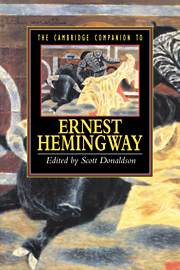Book contents
- Frontmatter
- 1 Introduction
- 2 Hemingway's journalism and the realist dilemma
- 3 1924
- 4 In Our Time, out of season
- 5 Brett and the other women in The Sun Also Rises
- 6 A Farewell to Arms
- 7 Hemingway's late fiction
- 8 Hemingway and politics
- 9 Hemingway and gender history
- 10 Hemingway, Hadley, and Paris
- 11 Hemingway's Spanish sensibility
- 12 The Cuban context of The Old Man and the Sea
- 13 Conclusion
- Selected Bibliography
- Index
- Series List
1 - Introduction
Hemingway and fame
Published online by Cambridge University Press: 28 May 2006
- Frontmatter
- 1 Introduction
- 2 Hemingway's journalism and the realist dilemma
- 3 1924
- 4 In Our Time, out of season
- 5 Brett and the other women in The Sun Also Rises
- 6 A Farewell to Arms
- 7 Hemingway's late fiction
- 8 Hemingway and politics
- 9 Hemingway and gender history
- 10 Hemingway, Hadley, and Paris
- 11 Hemingway's Spanish sensibility
- 12 The Cuban context of The Old Man and the Sea
- 13 Conclusion
- Selected Bibliography
- Index
- Series List
Summary
A full generation after his death Ernest Hemingway remains one of the most famous American writers. Even those who have never read a word he has written, in school or college or on their own, are aware of his presence in the world of celebrity - a rugged macho figure called Papa with a signature white beard. The outpouring of recognition and praise that followed his suicide on the morning of July 2, 1961, nearly obliterated the boundaries of space and time. Hemingway's passing was memorialized by the Kremlin and the White House, in the Vatican and the bullrings of Spain. “It is almost,” the Louisville Courier-Journal editorialized, “as though the Twentieth Century itself has come to a sudden, violent, and premature end” (Raeburn 168). Manifestly, at the time of his death he had become to the general public something more - or less - than a writer of stories and novels. He had become a legendary figure, and seems fated to remain one. Critics and college professors lament this state of affairs. The spurious anecdotes and half-baked biographies and Key West contests for Hemingway look-alikes only serve to draw attention away from his work, they assert, so that the great unwashed public will not take him seriously.
- Type
- Chapter
- Information
- The Cambridge Companion to Hemingway , pp. 1 - 15Publisher: Cambridge University PressPrint publication year: 1996
- 2
- Cited by

